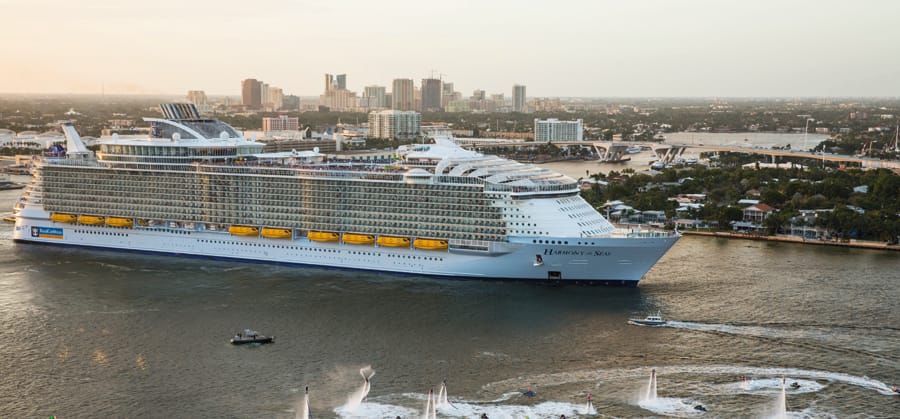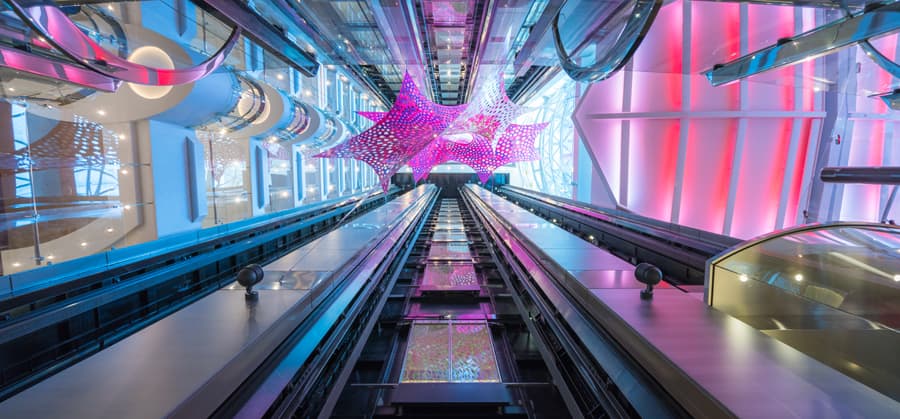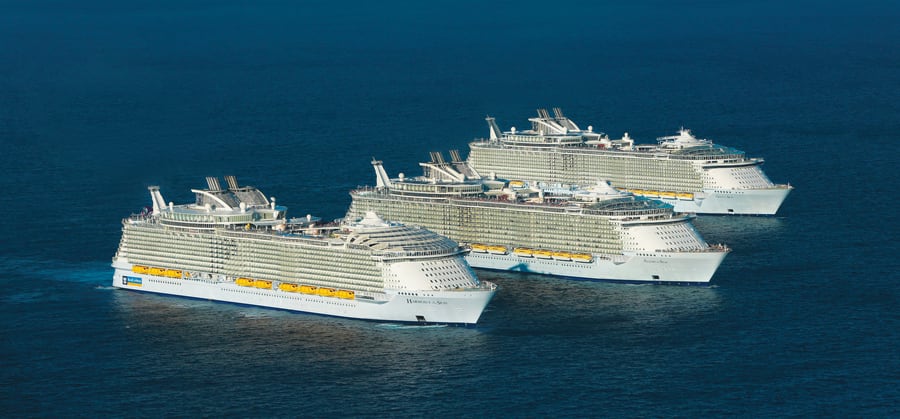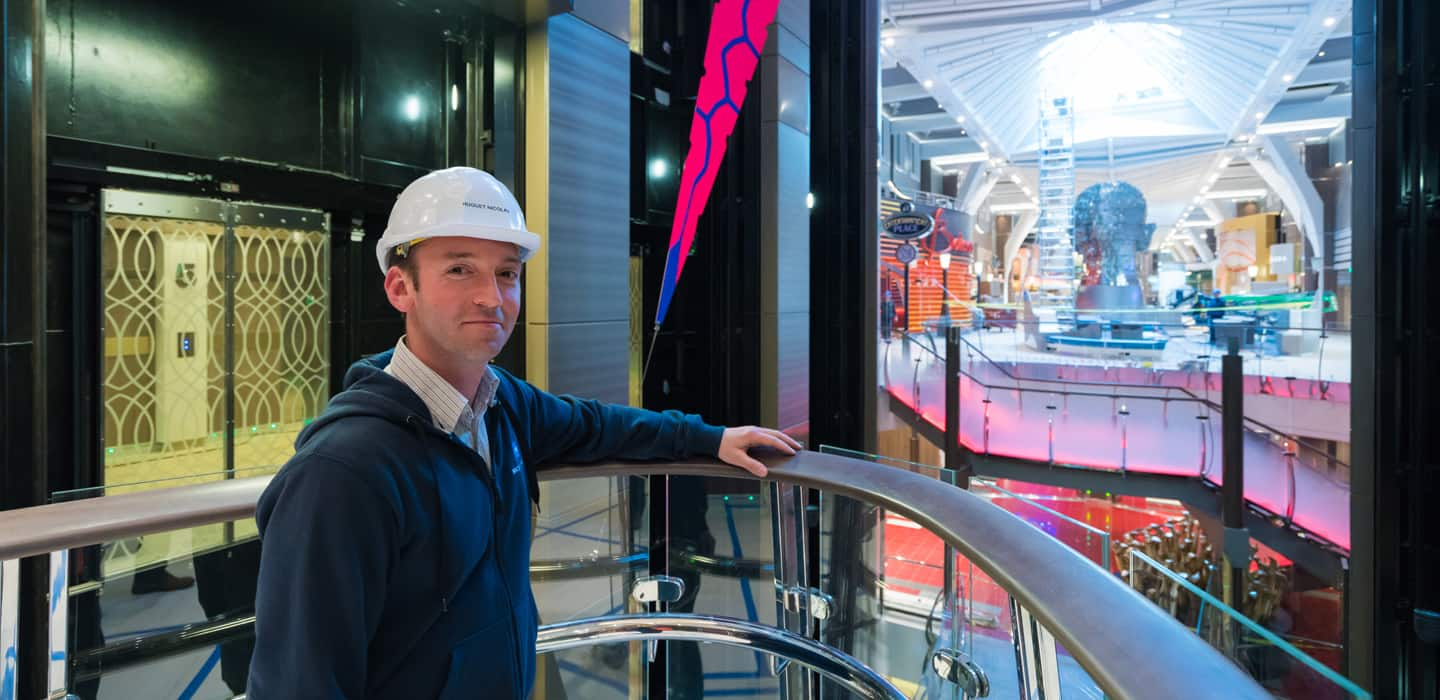
March 27, 2018
Think of a cruise ship and what comes to mind is a city, and the Harmony of the Seas, the newest addition to the Oasis Class fleet of Royal Caribbean Cruises Ltd. certainly fits the bill. Displacing nearly 227,000 gross tons, she was the largest passenger ship in the world when she first set sail in 2016, able to accommodate over 8880 passengers and crew. The vessel contains over 2,700 rooms spread out over multiple decks and contains facilities like water slides, surf simulators, rock climbing walls and even a miniature golf course. A veritable floating city indeed.
But unlike a city which has various modes of transport to help people get around, cruise ships are almost totally dependent on vertical transport solutions like elevators and escalators to get around. And not just any elevator either, as these massive vessels require specialized marine elevators to function properly.
Custom solutions for cruise ships

“They need to be rugged enough to withstand the constant motion of being at sea, while also being able to minimize vibrations and ensure that passengers don’t get nauseous,” says Nicolas Huguet, project manager at KONE Marine. “On top of that, they need to be compact since the space on cruise ships is very limited, unlike in buildings. Cruise ship operators need to maximize the space available for cabins and other attractions.”
KONE has developed several solutions that can help with this, including the MonoSpace™ elevators, an innovative technology that eliminates the need for a machine room, allowing Cruise Ship operators to use this space for other purposes. These specially designed marine elevators take into account factors such as the ship’s movement in the water, its pitch and roll, to ensure that rider comfort is looked after.
However, having the perfect product for a cruise ship is just one part of the challenge. The biggest challenge, emphasizes Huguet, is to keep up with the pace of construction. Unlike normal buildings where elevators are installed once the elevator shaft is in place, cruise ships require coordination right from the beginning of the project.
“A cruise ship is built using a system of blocks. A block can weigh more than a thousand tons and contain all the parts needed for a particular portion of the vessel. The shipyard then assembles hundreds of these blocks, almost like a big puzzle, into a complete ship,” explains Huguet. “This means we have to have the designs, the equipment and all materials ready right at the beginning so that we can install them as the assembly of the blocks progresses. Something we refer to as the plug-in method.”
Adapting to the situation
That is doubly true for a project as complex as the Harmony of the Seas, emphasizes Huguet, as he recalls a time when they had to redesign their plans completely.
“The ship owners wanted to increase the height of the cabins by 15 centimeters. That may not seem like a big number, but we had to re-evaluate all our plans to make sure that all the requisite height clearances were in place, which meant going back to the drawing board,” says Huguet. “Since we were working closely with the shipyard from the beginning, this was not a problem and we managed to change our plans accordingly.”
In fact, KONE's ability to adapt to circumstances and the proactive way in which the team carried out its tasks led to the shipyard giving KONE an award.
“That was the first time that the shipyard had ever given an award to a supplier,” recalls Huguet. “We received the award for long-term cooperation and one of the directors even talked about how he had never heard any complaints about KONE’s work. In fact, he even commended us for anticipating every need the shipyard had.”
Setting the standard

That is only natural when you consider KONE's decades of expertise and that fact that we have installed solutions for both Allure of the Seas and Oasis of the Seas, the two sister ships of the Harmony of the Seas. What’s more, KONE also won the contract to outfit two forthcoming Oasis-class vessels, further cementing our relationship with the RCCL.
That’s not all. KONE also installed advanced solutions to ease the flow of passenger traffic in cruise ships; with technologies like boarding mode and luggage mode, which can be activated to ensure that all elevators automatically go to the deck earmarked for this purpose. And if that wasn’t enough, all of KONE's elevators come equipped with energy-saving technologies like the EcoDisc which has regenerative drives that transfer 90% of the elevator’s braking energy back into the network.
Another factor that makes KONE the supplier of choice for the world’s biggest cruise operators is the company's extensive service network, says Huguet, and "we have technicians located in major ports around the world, including North America, Europe and Asia."
The Cruise Lines International Association (CLIA) estimates that a little over 24 million people travelled in cruise ships in 2016, and they are expecting this number to increase to over 25 million in 2017. We are certainly ready to help cruise ship operators handle these numbers.
